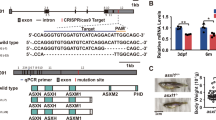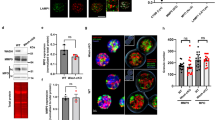Abstract
Cyclic hematopoiesis is a stem cell disease in which the number of neutrophils and other blood cells oscillates in weekly phases. Autosomal dominant mutations of ELA2, encoding the protease neutrophil elastase1, found in lysosome-like granules, cause cyclic hematopoiesis2 and most cases of the pre-leukemic disorder severe congenital neutropenia (SCN; ref. 3) in humans. Over 20 different mutations of neutrophil elastase have been identified, but their consequences are elusive, because they confer no consistent effects on enzymatic activity4. The similar autosomal recessive disease of dogs, canine cyclic hematopoiesis5, is not caused by mutations in ELA2 (data not shown). Here we show that homozygous mutation of the gene encoding the dog adaptor protein complex 3 (AP3) β-subunit, directing trans-Golgi export of transmembrane cargo proteins to lysosomes, causes canine cyclic hematopoiesis. C-terminal processing of neutrophil elastase exposes an AP3 interaction signal responsible for redirecting neutrophil elastase trafficking from membranes to granules. Disruption of either neutrophil elastase or AP3 perturbs the intracellular trafficking of neutrophil elastase. Most mutations in ELA2 that cause human cyclic hematopoiesis prevent membrane localization of neutrophil elastase, whereas most mutations in ELA2 that cause SCN lead to exclusive membrane localization.
This is a preview of subscription content, access via your institution
Access options
Subscribe to this journal
Receive 12 print issues and online access
$209.00 per year
only $17.42 per issue
Buy this article
- Purchase on Springer Link
- Instant access to full article PDF
Prices may be subject to local taxes which are calculated during checkout





Similar content being viewed by others
References
Bieth, J.G. Leukocyte elastase. in Handbook of Proteolytic Enzymes (ed. Woessner, J.F.) 54–60 (Academic, San Diego, 1998).
Horwitz, M., Benson, K.F., Person, R.E., Aprikyan, A.G. & Dale, D.C. Mutations in ELA2, encoding neutrophil elastase, define a 21-day biological clock in cyclic haematopoiesis. Nat. Genet. 23, 433–436 (1999).
Dale, D.C. et al. Mutations in the gene encoding neutrophil elastase in congenital and cyclic neutropenia. Blood 96, 2317–2322 (2000).
Li, F.Q. & Horwitz, M. Characterization of mutant neutrophil elastase in severe congenital neutropenia. J. Biol. Chem. 276, 14230–14241 (2001).
Lothrop, C.D. Jr. et al. Cyclic hormonogenesis in gray collie dogs: interactions of hematopoietic and endocrine systems. Endocrinology 120, 1027–1032 (1987).
Dell'Angelica, E.C., Shotelersuk, V., Aguilar, R.C., Gahl, W.A. & Bonifacino, J.S. Altered trafficking of lysosomal proteins in Hermansky–Pudlak syndrome due to mutations in the β3A subunit of the AP-3 adaptor. Mol. Cell 3, 11–21 (1999).
Huizing, M. et al. Nonsense mutations in ADTB3A cause complete deficiency of the β3A subunit of adaptor complex-3 and severe Hermansky–Pudlak syndrome type 2. Pediatr. Res. 51, 150–158 (2002).
Boehm, M. & Bonifacino, J.S. Genetic analyses of adaptin function from yeast to mammals. Gene 286, 175–186 (2002).
Simpson, F., Peden, A.A., Christopoulou, L. & Robinson, M.S. Characterization of the adaptor-related protein complex, AP-3. J. Cell Biol. 137, 835–845 (1997).
Bonifacino, J.S. & Dell'Angelica, E.C. Molecular bases for the recognition of tyrosine-based sorting signals. J. Cell Biol. 145, 923–926 (1999).
Rapoport, I., Chen, Y.C., Cupers, P., Shoelson, S.E. & Kirchhausen, T. Dileucine-based sorting signals bind to the beta chain of AP-1 at a site distinct and regulated differently from the tyrosine-based motif-binding site. EMBO J. 17, 2148–2155 (1998).
Feng, L. et al. The β3A subunit gene (Ap3b1) of the AP-3 adaptor complex is altered in the mouse hypopigmentation mutant pearl, a model for Hermansky–Pudlak syndrome and night blindness. Hum. Mol. Genet. 8, 323–330 (1999).
Aguilar, R.C. et al. Signal-binding specificity of the μ4 subunit of the adaptor protein complex AP-4. J. Biol. Chem. 276, 13145–13152 (2001).
Gullberg, U. et al. Carboxyl-terminal prodomain-deleted human leukocyte elastase and cathepsin G are efficiently targeted to granules and enzymatically activated in the rat basophilic/mast cell line RBL. J. Biol. Chem. 270, 12912–12918 (1995).
Bainton, D.F. Distinct granule populations in human neutrophils and lysosomal organelles identified by immuno-electron microscopy. J. Immunol. Methods 232, 153–168 (1999).
Horwitz, M. et al. Role of neutrophil elastase in bone marrow failure syndromes: molecular genetic revival of the chalone hypothesis. Curr. Opin. Hematol. 10, 49–54 (2003).
Yang, W., Li, C., Ward, D.M., Kaplan, J. & Mansour, S.L. Defective organellar membrane protein trafficking in Ap3b1-deficient cells. J. Cell Sci. 113, 4077–4086 (2000).
Moller, S., Croning, M.D. & Apweiler, R. Evaluation of methods for the prediction of membrane spanning regions. Bioinformatics 17, 646–653 (2001).
Owen, C.A., Campbell, M.A., Sannes, P.L., Boukedes, S.S. & Campbell, E.J. Cell surface-bound elastase and cathepsin G on human neutrophils: a novel, non-oxidative mechanism by which neutrophils focus and preserve catalytic activity of serine proteinases. J. Cell Biol. 131, 775–789 (1995).
Fuks, A., Zucker-Franklin, D. & Franklin, E.C. Identification of elastases associated with purified plasma membranes isolated from human monocytes and lymphocytes. Biochim. Biophys. Acta 755, 195–203 (1983).
Allen, D.H. & Tracy, P.B. Human coagulation factor V is activated to the functional cofactor by elastase and cathepsin G expressed at the monocyte surface. J. Biol. Chem. 270, 1408–1415 (1995).
Kolkenbrock, H., Zimmermann, J., Burmester, G.R. & Ulbrich, N. Activation of progelatinase B by membranes of human polymorphonuclear granulocytes. Biol. Chem. 381, 49–55 (2000).
Kaup, M. et al. Processing of the human transferrin receptor at distinct positions within the stalk region by neutrophil elastase and cathepsin G. Biol. Chem. 383, 1011–1020 (2002).
Clark, J.M., Vaughan, D.W., Aiken, B.M. & Kagan, H.M. Elastase-like enzymes in human neutrophils localized by ultrastructural cytochemistry. J. Cell Biol. 84, 102–119 (1980).
Mardones, G. & Gonzalez, A. Selective plasma membrane permeabilization by freeze-thawing and immunofluorescence epitope access to determine the topology of intracellular membrane proteins. J. Immunol. Methods 275, 169–177 (2003).
Vita, F., Soranzo, M.R., Borelli, V., Bertoncin, P. & Zabucchi, G. Subcellular localization of the small GTPase Rab5a in resting and stimulated human neutrophils. Exp. Cell Res. 227, 367–373 (1996).
Kjeldsen, L., Bainton, D.F., Sengelov, H. & Borregaard, N. Structural and functional heterogeneity among peroxidase-negative granules in human neutrophils: identification of a distinct gelatinase-containing granule subset by combined immunocytochemistry and subcellular fractionation. Blood 82, 3183–3191 (1993).
Danielson, P.B. The cytochrome P450 superfamily: biochemistry, evolution and drug metabolism in humans. Curr. Drug Metab. 3, 561–597 (2002).
Paigen, K. Mammalian β-glucuronidase: genetics, molecular biology, and cell biology. Prog. Nucleic Acid Res. Mol. Biol. 37, 155–205 (1989).
Acknowledgements
We thank J. Miller for help with microscopy, E. Ostrander for sample conveyance, G. Cuneo for collie photo, X. Zhu and J. Bonifacino for reagents and advice and M. Gelb, E. Davie and the late H. Neurath for critical discussion. This work was supported by grants from the US National Institutes of Health, Doris Duke Foundation (in vitro studies only) and Burroughs-Wellcome (to M.H.).
Author information
Authors and Affiliations
Corresponding author
Ethics declarations
Competing interests
The authors declare no competing financial interests.
Rights and permissions
About this article
Cite this article
Benson, K., Li, FQ., Person, R. et al. Mutations associated with neutropenia in dogs and humans disrupt intracellular transport of neutrophil elastase. Nat Genet 35, 90–96 (2003). https://doi.org/10.1038/ng1224
Received:
Accepted:
Published:
Issue Date:
DOI: https://doi.org/10.1038/ng1224
This article is cited by
-
Genetic Insights into Congenital Neutropenia
Clinical Reviews in Allergy & Immunology (2010)
-
Leader of the pack: gene mapping in dogs and other model organisms
Nature Reviews Genetics (2008)
-
AP-3 beta3a
AfCS-Nature Molecule Pages (2008)
-
Neutrophil serine proteases: specific regulators of inflammation
Nature Reviews Immunology (2006)
-
Can mutations in ELA2, neutrophil elastase expression or differential cell toxicity explain sulphasalazine-induced agranulocytosis?
BMC Hematology (2004)



